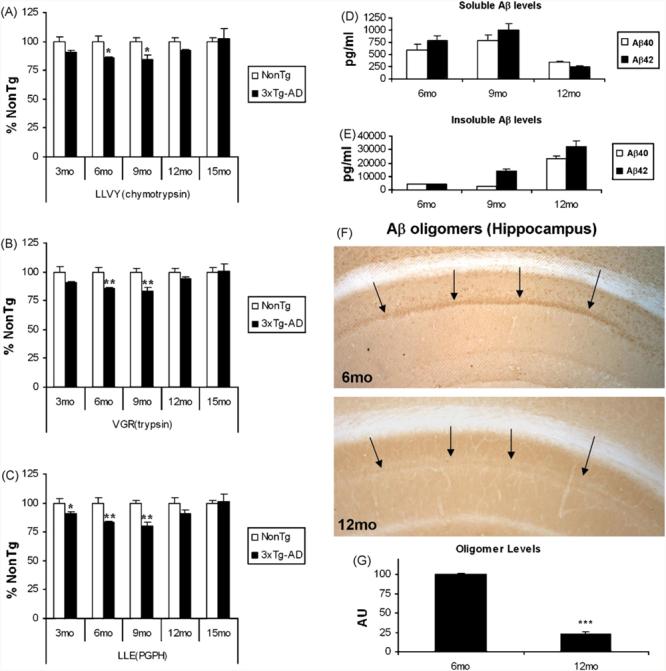Fig. 3.

Age-dependent impairments in proteasome activity in the hippocampus of 3xTg-AD mice. (A–C) Homogenates were prepared from the hippocampus of 3xTg-AD and age-matched NonTg mice. These homogenates were assay for chymotrypsin-like, trypsin-like and PGPH-like proteolytic activities. (A) ChT-L proteasome activity was impaired in the 3xTg-AD mice at all ages except for 15 months with significant impairments at 6 (85.7 ± 0.6% NonTg), 9 (84.0 ± 3.9% NonTg) and 24 (81.3 ± 2.1% NonTg) months. (B) T-L proteasome activity was impaired in the 3xTg-AD mice at all ages except for 15 months with significant impairments at 6 (85.7 ± 0.8% NonTg), 9 (83.1 ± 3.2 % NonTg) and 24 (83.6 ± 2.6 % NonTg) months. (C) ChT-L proteasome activity was impaired in the 3xTg-AD mice at all ages except for 15 months with significant impairments at 3 (90.9 ± 1.1% NonTg), 6 (83.4 ± 0.8% NonTg), 9 (80.1 ± 4.0% NonTg) and 24 (82.1 ± 2.5% NonTg) months. An n of at least 3 was collected for all ages and activities. (D) Soluble Aβ40 and Aβ42 levels were assayed by ELISA from 6-, 9- and 12-month-old 3xTg-AD mice brain homogenates. Soluble Aβ levels appear to increase between 6 and 9 months but decrease between 9 and 12 months. (E) Insoluble Aβ40 and Aβ42 levels were assayed by ELISA from 6-, 9- and 12-month-old 3xTg-AD mice brain homogenates. Insoluble Aβ levels appear to increase steadily between 6 and 12 months of age. (F, G) Aβ oligomers are readily detected at 6 months of age in the 3xTg-AD hippocampus but by 12 months are still present but are markedly more difficult to visualize. The anti-Aβ oligomer antibody A-11 was used for immunohistochemistry and the data shown are representative of at least three animals per age. Significance denoted as, *p < 0.05, **p < 0.01, ***p < 0.001.
